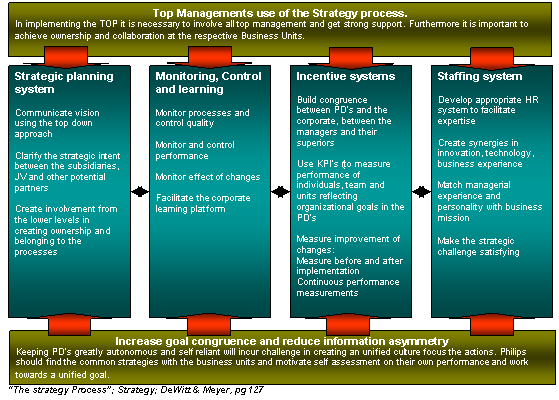Q3. What can be done about these problems? Distinguish between short-term and long-term solutions, and indicate where these problems are located.
The problems faced by Philips China mentioned earlier are the main reasons why the company is in trouble and showing losses for the years (2001-2002). According to this analysis there has been located areas where a specific problem exits and proposed the following solution for the respective problem:
Double line reporting
The double line reporting oppose serious issues and creates problems like, slowing processes, complex decision making, unclear responsibilities in terms of evaluation and finally control. The problem lies at both the country and the regional level.
The old hierarchical structure allowed a clear reporting line but the new matrix organisation complicated the situation and grew out of control with further expansion. Reporting lines with clear responsibilities and ownership must be defined and allocated with proper reporting systems in the units. This is to create transparency and to avoid opportunistic behaviour from the respective business units. In the Chinese context, this is especially important since the mindset of the workers- and management familiarity of clear instructions and hierarchical structures from SOEs. Introducing control systems will enable the employees to assess themselves, their work processes and procedures. Furthermore this performance measurement may enhance efficiency and quality, and continuously improve on all levels.
Decentralized business units & responsibilities centres
A short term goal for Philips should be to establish central or regional hubs to capture the synergies between the business units. This would be absolutely core in creating and maintaining future key success factors. The rapid growth together with matrix organisation has created problems as there is no alignment between the business units. Philips has not been able to capture the value added activities since the business units have been acting as independent companies. All the PDs should be aligned with each other in some respect so that they understand the common goal of the company. This will enhance the knowledge sharing among various units and promote innovation and collaboration leading to a long term competitive advantage.
For example, when there is integration among the units and knowledge sharing, then they can benefit from their collaborate experiences. Problems lies in the individual PDs, which are decentralized, working as independent units and not connected or coordinated with each other.
Cultural problem due to M&A’s and JV’s
After moving towards a matrix organisation, Philips was less able to impose direct control, on its acquired subsidiaries and JV acting as individual companies. Furthermore, the cultures differed significantly within the different units. It was difficult to align a common management control system. The mindset of the employees working in various PDs needed to change and focussed towards one common objective so that they understand what China office expects from them. It is important to find commonalities between the units’ strategies and build on these. Furthermore, Philips should impose stronger control measures on the high specific assets. Philips must involve the top management in conveying the vales and goals of the company to the employees and make them recognize its importance by initiating a two way communicating (i.e. internet, company newspaper, corporate meetings etc). Additionally it is important creating belonging and ownership for the processes to make them work easier. Changing this culture is time-consuming, if including high degree of involvement, and should bee seen as a long term strategic process
Ineffective governance structure
The matrix does not allow for a clear line of reporting compared to the old hierarchical structure. The double line reporting allows the units to potentially bypass one of the principals in pursuing an opportunistic approach. PD’s are pursuing JVs and M&As strategies in pursuing growth and they take their in house control structure to the resulting subsidiary, further aggravates the problems. All of this is happening due to the lack of an effective governance structure. Philips should apply different control measurement to different ownership structure, i.e. Bilateral (2 party) control structure for JVs and unified control model for WFOEs.
It is believed that is a short term solution to the overall problem of governing the PDs, JVs and M&As.
Cost inefficiencies
Philips should create cost centres; profit centres and investments centres, then define clear ownership of these responsibility centres. This will create high level of transparency due to easy traceability of costs. Key Performance Indicators (both for financial and non-financial) can be a possible tool to measure performance against corporate and industry targets. The KPIs will also help management to define areas for improvement. This could be a short term solution leading towards the elimination of problems in the long term.
The strategy should be formed on behalf of the common visions and goals of the organisation. Then Philips should try to find commonalities in strategy with the respective PD’s and from there together implement a top down approach of strategy thought the PD. The strategy implementation should go through the four phases as described in the figure (the strategic planning model) below and ensure that information flow runs through the organisation. Last it is important involve people, educate them and create ownership. This makes a better impact!
The Strategic Planning Model
